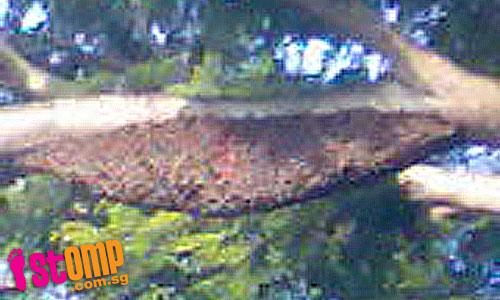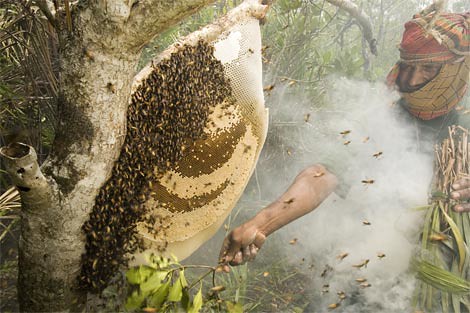
STOMPer Sim warns passers-by to beware of this huge beehive that is hanging precariously from a tree at Bedok North Avenue 3.
He says:
"A big beehive was found on a tree in front of Geylang United Football Club at Bedok North Ave 3.
"The beehive looks as if it is going to fall any moment.
"It is situated near the pedestrian walkway and that is quite dangerous.
"So passers-by, please beware of this beehive."
Related posts: "It only took 12 hours for these bees to infest my house toilet" (24th April 2009)
Bees, bees and more bees at Clementi! (6th April 2009)
Several beehives in overhead bridge leading to SGH (16th February 2009)
As mentioned in an older post about the bees and wasps of Singapore:
Singapore is home to 3 species of honeybee; the smallest and least aggressive species is the black dwarf honeybee (Apis andreniformis). The Asiatic honeybee (Apis cerana) is a close relative of the western honeybee (Apis mellifera) that forms the bulk of the global beekeeping industry. The third species, the giant honeybee (Apis dorsata), is the largest and most aggressive of our local honeybees.



The 3 honeybee species found in Singapore.
Left: Black dwarf honeybee (Apis andreniformis);
Middle: Asiatic honeybee(Apis cerana);
Right: Giant honeybee (Apis dorsata);
(Photo of Asiatic honeybee by budak, photos of black dwarf honeybee and giant honeybee are taken from vespa-bicolor.net)
Looking again at the photo in the original submission, I believe that the beehive in the photo might be a nest of the giant honeybee. This is one of the largest honeybees in the world, with workers measuring on average close to 20 millimetres in length.

Punggol;
(Photo by federickho)
The giant honeybee is particularly interesting in terms of its ecology and behaviour. This is a very aggressive species that has never been domesticated, but nonetheless has been exploited for centuries for its honey. There are tribes and societies in some countries that still have a tradition of harvesting honey from the hives of this species, often at great risk of injury or death; not only are these bees highly aggressive and willing to sting, but they tend to build their nests at great heights.

Gathering honey from hive of giant honeybee in Sunderbans, Bangladesh;
(Photo by jeromejin)
Unlike other honeybee species, which build their nests in holes and crevices, the giant honeybee nests in the open; hives usually consist of a single large honeycomb attached to a tree branch or under a cliff overhang, or sometimes on the ceiling or wall of a building.

Thailand;
(Photo by Sean Hoyland)

Malaysia;
(Photo by Stephen L. Buchmann and Gary P. Nabhan)

India;
(Photo by Bruce G. Marcot)
The nest is typically covered by a dense mass of bees.

India;
(Photo by Bksimonb)
The giant honeybee has a very interesting defense mechanism to ward off predators. Of course, it is always possible for the bees to defend their nests by swarming all over intruders and stinging them, but it is best used as a last resort; honeybee stingers have barbs, which prevent the bee from withdrawing its stinger properly. After stinging, the stinger and the associated venom gland are literally torn out of the bee's abdomen as it flies or crawls away. And so, honeybees are able to sting only once, and die shortly after. Instead of sacrificing precious workers unnecessarily each time an animal approaches the nest, the giant honeybee has evolved a unique display to warn intruders away.
Here's the legendary Sir David Attenborough to tell you more.
This shimmering behaviour (often endearingly compared to the Mexican waves seen at football matches) has been shown to be effective at deterring predatory wasps. Individual bees being pursued by wasps will head straight for the safety of the nest, triggering a wave of shimmering as the predator approaches. Confronted by a mass of shimmering bees, the wasp beats a hasty retreat. This certainly is an interesting study in self-organisation and group intelligence.
Kastberger, G., Schmelzer, E. & Kranner, I. 2008. Social Waves in Giant Honeybees Repel Hornets. PLoS ONE, 3(9), 1-16.
Here are a couple of videos about this particular study: